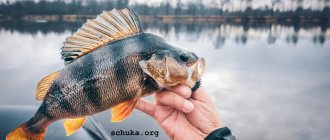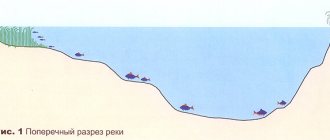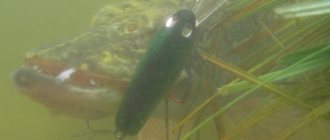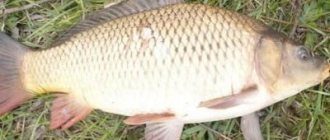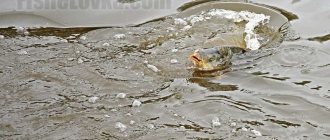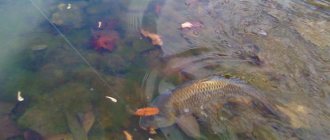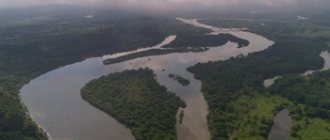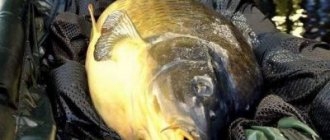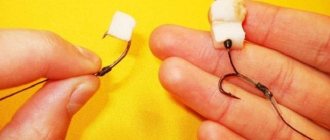Finding yourself on an unfamiliar body of water, you have to look for a promising place for fishing, and this is not at all easy. Although it is not easy for novice fishermen, experienced fishermen will be able to quickly identify promising places by the nature of the movement of water in the reservoir. If this is a pond and the movement of water is limited by gusts of wind, then it is somewhat more complicated. In this case, completely different criteria for determining where fish are concentrated come into force.
How to choose a fishing spot on the river
On the river it is much easier to find a catchable place that may differ from the general background or stand out from it. If the river is winding, then it is very easy to determine the nature of the river bottom based on the pattern of the coastline. As a rule, on such rivers, cliffs are clearly visible, near which the river can have optimal depths where most species of fish leading a bottom-dwelling lifestyle can be found. On winding rivers, the nature of the water flow depends on the size of the bends, and the depths can be determined by the color of the water.
Promising places for fishing on the river
They can be bays, oxbows and bends. The outer banks of the bends form cliffs, where there are the deepest places, and the inner banks form shallows. In narrow sections of the river, where there are weak currents, there are deeper places than in wide ones. In areas of rapids, it is easy to determine a deeper place by the color of the water, which in such places has a darker color. Downstream, if you go from the riffle, so-called whirlpools, or deep holes, are formed, where larger fish and predators are certainly located. The current is weaker on the reaches than on the rifts. The depth of the reaches is more constant and can change smoothly from the banks to the core, where the fastest current is present.
On small rivers
On small rivers, catchable places can be found in pits; on narrow rivers - places where the channel widens, as well as bays; on rivers with a slow flow - narrowing of the channel, places of rapids and channels, and on rivers with a fast flow - spills and bays; on deep rivers - the boundaries of depths and shallows, channels and “furrows” that separate the shallows from the shore, as well as at the border of algae. Fish can be found near blocks of soil that are washed into the water near cliffs.
Places where cattle gathered to drink in the evenings were always considered promising. At this moment, the fish stays closer to the border of the turbidity that the animals raise. Of particular interest are places littered with snags or driftwood. At the very top of the pool, where the current rushes in from the riffle, large specimens of fish, as well as predators, stay. A little further, where the current is not so strong, fish such as ide and chub like to spend time. The middle of the pool and its edges are occupied by other species of fish.
You should not pass by waterways where reverse currents predominate. They are usually located behind various obstacles that change the direction of movement of the bulk of the water. The smaller the distance between the forward and reverse currents, the more interesting the water is for fish.
Holes with thickets of trees and bushes that hang over the water can be
a good place for fishing Shallows that rarely extend into the depths can also be effective.
Studying the reservoir and searching for fish
- VK
A fisherman who finds himself on any body of water for the first time is faced with the question: where to look for fish? The same question arises when fishing conditions change in old, well-explored places. Many fishermen waste time searching for fish sites even in unfamiliar bodies of water.
And only a few fishing enthusiasts, naturally endowed with powers of observation, are able to notice much that has escaped the attention of others, draw conclusions and make appropriate decisions. They, sparing no time and effort, are quicker than others to comprehend the features of new reservoirs, study their topography, depth and bottom soil, the nature of the flow, determine the placement of snags, driftwood and boulders, as well as the location of algae. They almost accurately determine the location of various fish and the best time to catch them, taking into account the entire sum of natural phenomena: water and air temperature, wind direction and strength, color and water level, arrival and departure of birds, flowering of plants, appearance of insects, conditions of ice and snow, as well as other signs.
It is difficult, and often useless, to look for fish if it stops feeding and biting. A sharp and significant change in atmospheric pressure disrupts the vital balance of the inhabitants of the aquatic environment. For studying and especially searching for fish sites, long-term stable weather is most favorable. Before the weather changes, the bite improves for a short time, after which it drops sharply or stops altogether.
The more abruptly the weather changes, the stronger, but shorter in time, the fish eats.
There are a number of rules that help you study a body of water and find fish depending on weather conditions. When the water level rises, especially if the water overflows the banks, the fish leave their usual camps and disperse into the floods, where they find a lot of food, or, moving against the current, enter tributaries. During the summer drop in water level, the fish, showing restlessness, looks for deep, high-water places, for which they often slide downstream and leave shallow water bodies. The bite during such movement worsens significantly. The situation is different with a slow decrease in the level of flood waters that have not yet reached low water. In this case, the fish are forced to return to the riverbed, to their usual habitats, which increases their numbers and competition in food.
The places where fish accumulate and grow fat in normal times, if they are not disturbed by nets, are quite constant. Therefore, when searching for fish, one should be guided by the observation of L.P. Sabaneev: the more any part of a reservoir differs from its general character, the more likely one can expect an accumulation of fish on it. As a rule, catchable places on rivers always stand out in some way.
The fish also choose contrasting places on lakes and reservoirs, but their differences are often hidden under water. However, something can be noticed here too. In clean water bodies that are not overgrown with algae, fish are attracted to islands and clumps of rare algae. In overgrown reservoirs, it collects in clearings of clean water and in windows. In reservoirs, fish, without staying long in certain places, move along the edges (beginnings) of dumps into the depths of holes, channels, and ravines, especially if there is a noticeable current there.
In the heat, you need to look for fish in the shade of coastal trees, bushes and cliffs, and this should best be done at the end of the night and early in the morning. In autumn, as the water cools, you should look for fish in the afternoon and evening, when the water warms up. In summer, the fish lives among algae, and at night goes to clean, unovergrown shores and shallows, where the water cools faster and is better saturated with oxygen. Lake fish approach the mouths of tributaries, springs, or stay in the upper layer of water, above the temperature jump layer. In late spring and early summer, it is attracted to the banks of a reservoir that plunge steeply into the water, especially if they are overgrown with spreading trees and bushes. Insects and slugs living on leaves and branches fall into the water in abundance during wind and rain.
In autumn, the fish feeds in places rich in drooping algae, collecting from them a “harvest” of seeds, as well as larvae and aquatic insects that have lost shelter. In all cases, you should talk to local fishermen, who can tell you not only about fishing spots, but also fishing methods and bait. And yet, any large lake and reservoir is worthy of attention and careful personal study.
On reservoirs and lakes, a lot can be understood after familiarizing yourself with the outlines and topography of the banks. For example, near a gently sloping coastline there are usually no depths. If the high banks go steeply into the water, one can expect that the depths are adjacent to the shores. Algae, which are rarely found at depths of more than 4 m, will help complete the picture. At a depth of about 4 m, pondweed, urut, elodea and hornwort can grow. Water lilies grow at a depth of up to 3 m, egg capsules - a little deeper, reed and kuga - up to 2 m, horsetail - up to 1.5 m. Sedge and cattail are common at a depth of up to 1 m and are coastal plants. The blue-green algae growing at a depth of up to 6 m, called “water moss” by fishermen, are not visible from above. There are also floating plants, bladderwrack and duckweed, which are carried by the winds and show the direction of the prevailing winds in the recent past.
Snags, underwater shallows and holes, beds of tributaries and ravines cannot be detected without sounding the depths from a boat or raft. On rivers, finding fishing spots is simplified. Coastal lines, traces of currents and the color of water, which changes depending on the depth, help here. Small rivers, winding along the floodplain, form bends, bays and oxbow lakes. Near the outer bank of the bends there are the greatest depths: the current, eroding the soil, forms cliffs here - holes. There is a sandbank near the inner shore. Narrow sections of the river with a quiet flow are deeper than wide ones.
On rivers, shallow places with fast currents are called riffles. The deepest place of the riffle—the “trough”—is easily identified by the darker color of the water. Below the rifts, whirlpools often form - deep holes that are favored by large fish and predators. Straight or slightly winding areas between the rifts are called reaches, and the current there is always weaker than on the rifts and near the ravines. The depth of the reach increases more or less evenly from the banks to the core—the area of the fastest current.
In small rivers, the best places for fishing are pits, and in narrow rivers, widenings and bays; in slowly flowing ones - narrowings, channels and rifts; in fast ones - spills and gulfs; in the deep ones - the boundaries of shallows on dumps in depth, channels and “furrows” separating shallows and islands from the shore, as well as the edge of algae.
Fish are also attracted by blocks of soil washed into the water near the ravines. Places near watering holes are good, especially when cattle appear on them before sunset. The fish here stay close to the edge of the mud raised by the cattle. Interesting pools littered with driftwood, snags and boulders; waterways with a reverse current, located behind capes and other obstacles that deflect the main current from the shore. The smaller the distance between the direct and reverse stream, the more attractive the water is for fish. Beautiful places are holes overgrown with trees and bushes hanging over the water.
Sometimes there is good fishing along the inner bank of the bend, if the shallows drop steeply into the depths. You should always prefer a section of the river upstream from a large populated area: wastewater scares away fish, especially large ones. There is good fishing in an oxbow lake - if it has a deep enough outlet into the river and on the river at the outlet of the oxbow lake. Fishing is excellent below riffles, rapids, dams and locks. At the very top of the pool, predators and large fish hang around the current rushing in from the riffle. Further, as the current weakens, chub and ide take their place, and other species of fish live in the middle and along the edges of the pool.
Fish from lakes and reservoirs are most sensitive to the influence of winds. The rivers are only affected by the influence of strong winds in areas directed along the reaches. However, bream and silver bream, sometimes carp and carp are exceptions. No wonder fishermen say: “a storm knocks bream off the bottom.” Indeed, these fish always come to the surf to feed. The upstream current of the wind surge, resting against the steep bank, falls to the bottom and, knocking out bloodworms and other living creatures from the coastal silt, carries them away from the shores. Here they fish from the bottom, often with bottom rods or without a float. The best places are on headlands parallel to the surf.
It is also necessary to keep in mind the biting time and water illumination, which is especially important when catching fish that feed only during the daytime. Even bream in the depths begins to bite much later than in shallow places. At the end of the night and at dawn it is better to start searching for fish in more or less shallow places. In clear water and in clear weather, you should fish at depth, and in muddy water and cloudy weather, it is better to linger in shallow places until sunrise.
In conclusion, I would like to warn fishermen not to rely only on ready-made recipes. You need to learn how to find fish yourself and use certain techniques to catch them. No wonder they say: “a book is a book, but move your mind!” Indeed, the fish’s bite and its location are influenced not by individual weather and natural phenomena, but by their entire complex. This means that the whole sum of phenomena must be taken into account, and first of all the most significant ones. This is where your own experience is needed. After all, someone else’s experience becomes more valuable when it is tested personally and also becomes, as it were, your own. In addition, those authors of individual books may make inaccuracies. Even the statements of the classic of our fishing literature L.P. Sabaneev sometimes require clarification. For example, he points out in the “Fishing Calendar”: “The gain or loss of water is noticeably reflected in the bite, namely: the more water arrives, the worse the bite, and vice versa.”
Indeed, fluctuations in water levels affect the life of fish; many leave their “habitable” places, and the bite may stop. However, when the water level rises, the fish come out into the floods and here they increase their feeding. Their stomachs are filled with worms and leeches. As the level drops, the bite actually intensifies at first, as the fish move to the pits, where food competition intensifies. With a constant and rapid decrease in water, the fish becomes restless, weakening or completely stopping feeding. It leaves its usual places, sliding downstream, some leaving shallow rivers.
Sabaneev writes there: “The wind and to a certain extent cold always favor biting, especially with bottom fishing rods; calm and heat are the opposite.” Clarifications are also needed here. Wind and cold do not always favor biting, but only after a lull and heat. In spring, autumn and winter they often lead to a complete cessation of biting. And even in summer, if this is due to a sharp change in weather and atmospheric pressure, the fish often stops biting on the first day. There has long been a debate among fishermen about what is better: looking for fish or waiting for it to come? I think it's always better to look. It’s not for nothing that the song says: “he who seeks will always find!”
N. Lopatin
Related articles:
Poisonous fish
Table of lakes and reservoirs in Belarus
Lake Kugurluy
Sula River and its tributaries
How to choose a fishing spot on a lake or reservoir
Fish everywhere, in any body of water, choose characteristic places, which are sometimes hidden under the water column. This is especially true for lakes and reservoirs, but even here, if you look carefully, you can easily find the favorite places of fish. In reservoirs with dense vegetation, fish may be in “clearings” or in windows of clear water. She doesn’t mind stopping at islands that have minor algae thickets. As for reservoirs, fish constantly migrate in them through holes, ravines, along edges and slopes, especially if there is a current in such places.
Determination of bottom relief
If you are very careful, the bottom topography can be determined by the pattern of the river bed and the presence of this or that vegetation. Plants such as hornwort, urutu or villain can grow at depths of more than 4 meters. At depths of up to 3 meters water lilies grow, a little deeper - egg capsules, at depths of up to 2 meters okuga and reeds grow, and a plant such as horsetail has chosen depths of up to 1.5 meters. Coastal plants such as cattail and sedge grow at depths of up to 1 meter. At depths of up to 6 meters, algae called “water moss” grow, invisible to fishermen.
Floating plants such as duckweed and bladderwort can be found on bodies of water and can indicate the direction of prevailing winds.
Summer
At the beginning of summer, the water is already well saturated with oxygen, rapid growth of plants begins and all the fish disperse throughout the reservoir to different places. At this time, the predator can be found anywhere, as it also scatters throughout the entire reservoir.
In mid-summer, although the water on the surface is well saturated with oxygen, it is too warm for a comfortable habitat for peaceful fish. At the bottom, on the contrary, there is very little oxygen and the fish are not comfortable there. Therefore, it will look for places where there is oxygen and the temperature does not change much during the day, these are various places where cold springs flow, dams, well-shaded areas.
We recommend: Fisherman's calendar for 2021, favorable days for fishing
During the daytime, it practically does not move around the reservoir, but by night it begins to move around the reservoir in search of food. Look for the predator in shaded areas with an influx of fresh water and the presence of shelters, and at night it is highly likely to hide behind shelters in shallow water.
At the end of summer the situation does not change. Peaceful fish are found in places above significant temperature differences.
Water level fluctuations
Such conditions significantly affect the life of fish and other organisms. An increase in water level can contribute to the departure of fish from their usual stopping places, which entails a cessation of biting. This, in turn, can lead to an increase in the bite on spills, as it rushes there in search of food.
When the water level drops, the fish may become restless and refuse the bait offered to it. Larger fish slide downstream, leaving their usual places and shallow rivers.
If the water decrease occurs very slowly, then the fish may not respond to such conditions. She settles into her usual places and actively feeds at the same time. During this period, you can catch both small and trophy fish.
The influence of weather on fish aggregations
Ambient temperature, atmospheric pressure, at a constant water level, significantly affect the effectiveness of fishing. When the weather changes, as well as when the weather is stable, the fish may bite differently. It was noticed that the fish began to actively feed before a thunderstorm or during rain, and after the rain and thunderstorm stopped, they also stopped pecking. Changing natural conditions affect fishing performance not only in summer, but also in spring, autumn and winter. Even with changes in wind direction, fish activity changes.
Experienced anglers use the wind to find fishing spots. For those who hunt bream, silver bream, crucian carp and carp, it is important to know that the wind, directing waves to the shores, brings these fish to the feeding area. The fact is that waves select various living creatures from the coastal zone and carry them from the shores to the depths. In such places you should use feeder gear or simple “donks”. Effective places in this case are on capes located parallel to the surf.

